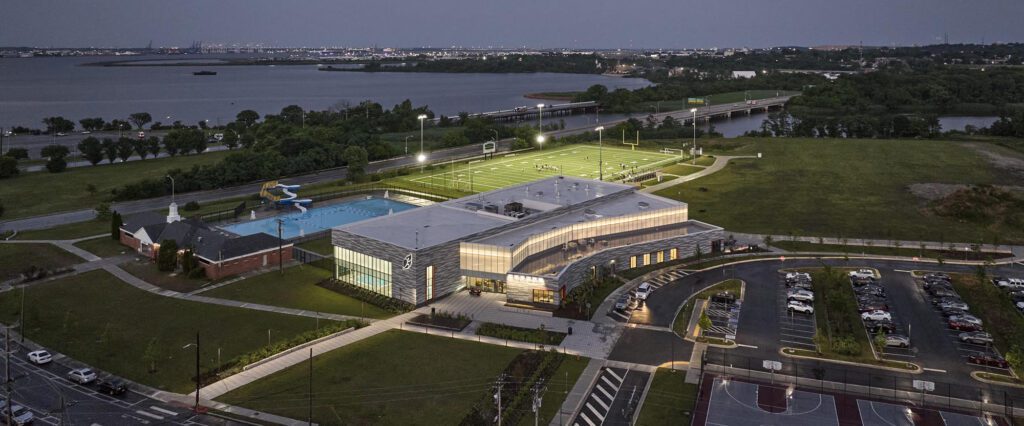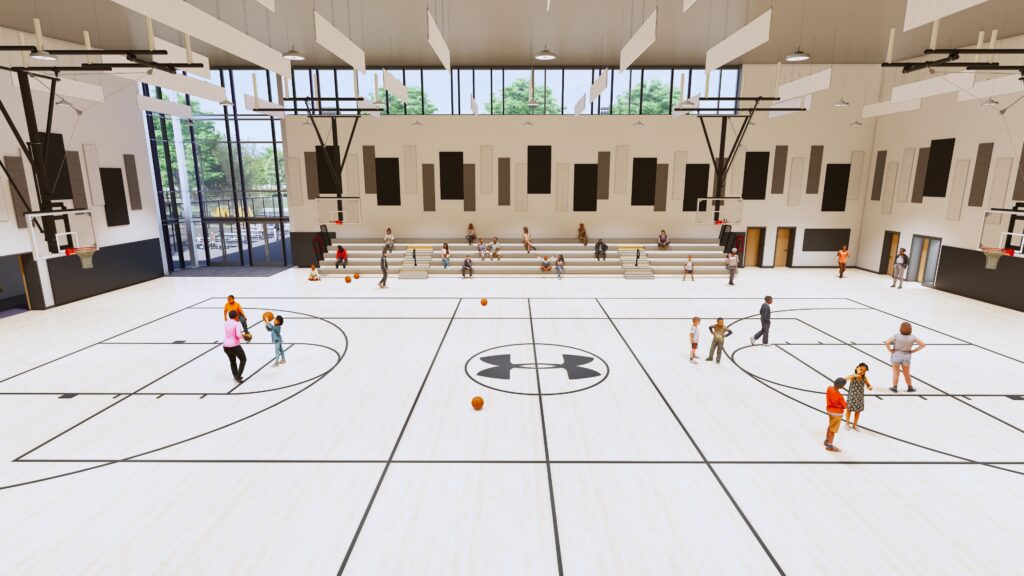Rec center projects deliver broader amenities, more beautiful buildings
Gone are the days when a community recreation center was a basic building, a gym and a ballfield.
Today’s rec center projects involve a mix of high-quality athletic facilities with space for creative activities, high-tech activities, public meetings, performances, food preparation and support services. They feature artful facades, welcoming interiors, high-performance systems and custom designs. Yet they are still delivered with limited budgets, broad stakeholder groups and often on distressed sites.
They are projects that require a high level of ingenuity but deliver big benefits to the communities they serve.

Last fall, AIA Maryland named the Middle Branch Fitness and Wellness Center as the 2024 Public Building of the Year while AIA Baltimore named the center as winner of its Social Equity Award. The project team included BC&E members Alliance Exterior Construction, GWWO Architects, Hatzel & Buehler, Ironshore Contracting, MK Consulting Engineers and The Whiting-Turner Contracting Company.
Located on a former brownfield site, the center was designed to serve the distinct needs of the Cherry Hill neighborhood. The light-filled building includes a gymnasium, natatorium, indoor splash pad, fitness area, multipurpose studio, maker space, classroom and rooms for support services. Outside, the grounds include a turf field for football, lacrosse and soccer as well as an event lawn and a connection to the 15-mile Gwynns Falls Trail.
To maximize the center’s facilities and usefulness, GWWO Architects designed the building to minimize non-program space and support multiple and changing uses in different areas.
For Middle Branch and a previous project (Cahill Fitness and Wellness Center in Baltimore), “we basically worked to eliminate circulation space,” said John Gregg, Principal at GWWO. “There aren’t corridors. The workout facilities are incorporated into the lobby and into the circulation. The multi-purpose spaces are made as multi-use and flexible as possible.”
The Cahill project team included BC&E members Cole Roofing, GWWO Architects and MK Consulting Engineers.

However, the success of those projects “is really not only about the design,” Gregg said. “It’s about engaging the community.”
Extensive community sessions educated the project team about residents’ distinct needs and desires for a recreation center. They also convinced some understandably skeptical residents of underserved communities that their voices would be heard and acted on.
Ultimately, that produced changes and unique additions to the designs. At Cahill, designers added a large auditorium/performance space.
At Middle Branch, “a bright red, indoor walking track became an integral part of the design,” Gregg said. “It’s something that facility has that other recreation centers in the city don’t. But residents said they needed a walking track and they wanted it to be indoors. We were able to address that community need without a significant increase in cost.”
Other recreation center projects present different needs and desires.
In West Baltimore, a proposal to renovate the aging and underutilized Hilton Recreation Center mushroomed into a major, multi-sponsor redevelopment plan.
It started nearly six years ago when former Ravens wide receiver Torrey Smith and his wife, Chanel, began looking for a site to provide youth programming through their LEVEL82 organization. Since then, the initiative has attracted support from city and state governments as well as a roster of local philanthropists.

The Ravens Boys & Girls Club at Hilton Recreation Center will include a multi-purpose athletic field, a teen lounge, gymnasium, art room, technology room, tutoring spaces, indoor-outdoor community gathering spaces, and a kitchen. Image courtesy of Design Collective.
Based on the nature and needs of the community, the plan expanded into a major renovation that will create a multi-purpose athletic field (which will also serve the adjacent Green Street Academy), a teen lounge, gymnasium, art room, technology room, tutoring spaces, indoor-outdoor community gathering spaces, and a kitchen that will intersect with Green Street Academy’s urban agriculture program and support food insecurity efforts in the area.
When the project team finishes construction later this year, the new facility will be known as the Baltimore Ravens Boys & Girls Club at Hilton Recreation Center. That team includes The Whiting-Turner Contracting Company, MK Consulting Engineers, Ariosa & Company, Windsor Electric and Design Collective.
“A unique feature of this recreation center is it will not only serve the community, but also support the adjacent high school,” said Scott Vieth, Principal at Design Collective.
And despite the major involvement of the Ravens, “it can’t be all about sports,” said Matt Herbert, Principal at Design Collective. “It has to support the kids and the community in many other activities.”
Consequently, the design went through many iterations to meet that broad range of activities and to ensure the space can adapt to changing uses in future, Herbert said.
Built-in technology and tech spaces, for example, are designed to support the TikTok generation and adapt to whatever comes next.
“There are rooms that are specially treated for sound and lighting for content generation for social media,” Herbert said. “People from the Boys & Girls Club and Green Street Academy recognized that this is another way for kids to find what they want to do and there are entrepreneurial aspects to it, and you can’t be closed minded about those activities.”
In the midst of the litany of program requirements, current recreation center projects are also delivering superb aesthetics.
The new Hilton center will include “a lot of color and branding and really cool graphics,” Vieth said. “But it is probably the gymnasium that is going to wow people the most. They are going to walk into this brand new, giant gymnasium that is flooded with daylight. There are windows up high but there are also big, lower windows that look out onto the field.”

In East Baltimore, a project team that includes BC&E members CAM Construction, Coastal Exteriors, GWWO Architects and MK Consulting Engineers is currently working on the renovation and expansion of the Chick Webb Memorial Recreation Center. Dedicated to legendary jazz drummer and bandleader, William Henry “Chick” Webb, the original 1947 facility was the first rec center and pool built for African Americans in the city.
The two-story addition plus renovated space will create a modern gymnasium, natatorium, fitness/wellness spaces, a makerspace, teen lounge, walking/running track, historical displays about Webb’s career and a “Founder’s Recording Studio.” It will also add a gorgeous building to the neighborhood.
To honor both the history of the building and Webb’s legacy, the new façade will feature modern limestone panels and fenestration that reflect the style of the original, mid-century building. The design of the entryway will evoke both the pattern of a musical scale and the palette of Webb’s colorful drum kits.

The Bocek Recreation Center embraced a distinctly different design to meet the communities needs and history. Image courtesy of Plano-Coudon Construction.
At Middle Branch, design decisions created beauty inside and out. The elevated, indoor, walking track was aligned with the building’s glazing to provide walkers with broad views of the neighborhood and the waterfront beyond.
Outside, the façade featured “a checkerboard pattern of Ultra-High Performance Concrete (UHPC) in shades of gray and beige that are bordered with red ACM panels to accentuate different architectural features,” said Skutch Montgomery, Director of Sales and Estimating at Alliance Exterior Construction.
Alliance, he added, has seen the rise in aesthetic standards for recreation centers.
“About 25 years ago, we built the original Essex Community College pool and we’re still really proud of that original project,” Montgomery said.
But a few years ago, Alliance Exterior Construction was part of the project team that transformed the building into the CCBC Wellness Center. That renovation and addition included UHPC rainscreen panels on the exterior.
“For the original Essex Community College Pool, we did a custom tapered seam with TPO roofing membrane to make it look like a standing seam roof and that was the extent of any flashiness,” he said. “For the new addition, we installed an angular roof and a canopy that juts out from the building and creates a very welcoming entry. And we installed a textured UHPC skin on the building that blends into the original brick. It’s gorgeous.”

Projects completed decades apart at the CCBC Wellness Center showed the evolving aesthetic requirements for recreation centers. Photo courtesy of Alliance Exterior Construction.
Amid the drive to deliver more amenities and better aesthetics on limited budgets and pressing timelines, some recreation center projects are also embracing less than conventional building processes and materials, Plano-Coudon Construction is preparing to break ground in February on a 14,000-square-foot addition to the Bocek Recreation Center in Baltimore. The $11.1 million project will create a new indoor fitness area and gymnasium, add an outdoor basketball court and fitness area, and outfit the building with sustainable features, including rooftop solar.
“One of the most impressive aspects of this project is the design, fabrication and installation of the pre-engineered metal building (PEMB),” said Darryl Richardson, Project Executive with Plano Coudon. “PEMBs allow for a faster ground-up installation compared to traditional steel structures, making them an efficient solution for recreation center development.”